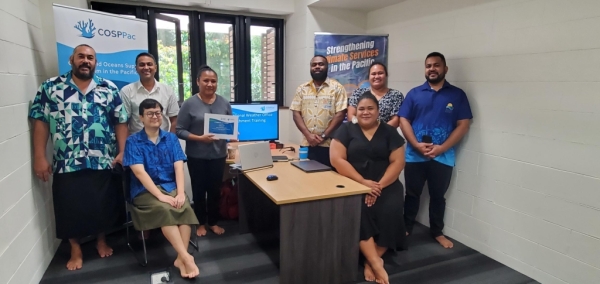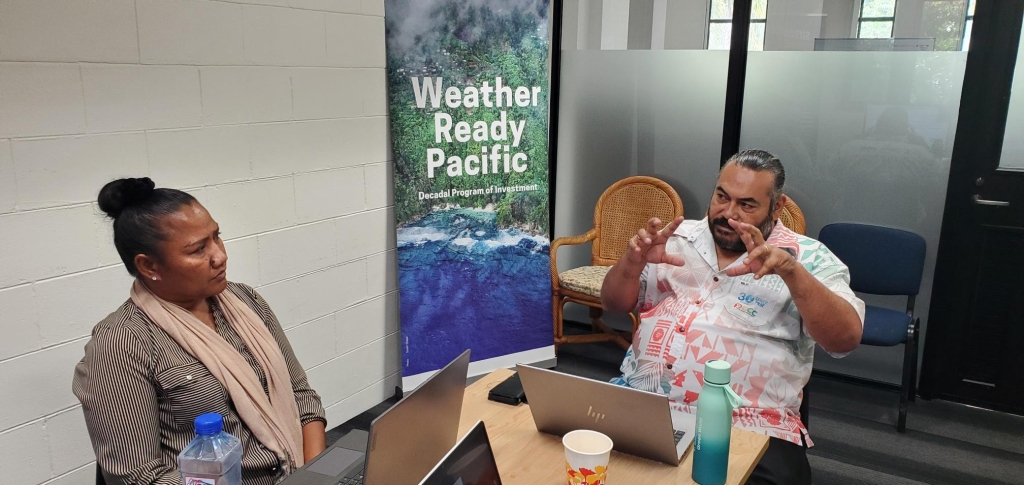
13 May 2025, Apia, Samoa – The Federated States of Micronesia is one of the most vulnerable countries in the world to the impacts of climate change. As His Excellency Mr. Jeem S. Lippwe, FSM Ambassador to the United Nations stated at the 29th Conference of the Parties to the United Nations Framework Convention on Climate Change held in Baku last year, climate impacts are not abstract statistics for FSM, they are their daily reality.
“Our days and nights grow steadily hotter, typhoons battering our shores are stronger and more frequent, and rising seas threaten our coastal communities,” Ambassador Lippwe said in a statement delivered to the COP.
The first line of defense for FSM against climate impacts is through their National Weather Services. Historically, the Federated States of Micronesia relies on the National Oceanic and Atmospheric Administration of the United States of America to monitor the weather and climate and also provide relevant weather, climate and ocean services and predictions to the state. The states have expressed the desire to be able to carry out their own climate seasonal predictions within their NWSs.
The Secretariat of the Pacific Regional Environment Programme (SPREP, through the Climate and Oceans Support Programme in the Pacific (COSPPac) Phase III project, has responded to this request and undertaken specific state in-country training on seasonal prediction.
A one-week secondment to SPREP’s Climate Science and Information programme for Ms. Katherine Tun, Climate Officer with the Yap State NWS took place earlier this month. The training she received during the secondment has equipped her with the capacity and tools to take back to Yap and enable them to carry out their own monthly seasonal prediction.

This also means that the Yap NWS will be able to join other Pacific National Meteorological and Hydrological Services (NMHS) during the monthly Ocean and Climate Outlook Forums hosted by the COSPPac . The monthly forum provides NMHSs and partners a platform to discuss the status of the climate and seasonal predictions derived through their monitoring systems.
“I am glad to now be part of a network that will help me to be more productive and independent in developing seasonal prediction. I am grateful to the COSPPac project for being a great support system and providing me with opportunities that will go a long way,” Ms. Katherine Tun says.
Practical exercises and training were provided on access to, and use of, the Seasonal Climate Outlooks in Pacific Island Countries (SCOPIC), a tool that generates seasonal outlook for rainfall, temperature, and other climate-related factors relevant to the Pacific, as well as the Australian Community Climate Earth System Simulators – Seasonal (ACCESS-S) model, which produces predictions of the El Niño-Southern Oscillation, as well as rainfall and temperature outlooks and sea surface temperatures.

Ms. Tun added that with the knowledge she now has of the tools, she feels more confident in her abilities to develop products that will ultimately benefit the people of Yap and contribute to a more resilient Pacific region.
“The Yap NWS can now contribute to the Pacific climate prediction activities through the OCOF process with the beginning of our own climate services in Yap State.”
According to Mr. Philip Malsale, COSPPac 3’s Senior Climatologist, the secondment was an excellent opportunity to provide support to the Yap NWS and ultimately build the resilience of local communities.
“By building prediction capacity with the Yap NWS, we want to ensure that timely, accurate information reaches the people so that they can protect their homes, livelihoods, and ultimately themselves from harm relating to climate extreme events,” Mr. Malsale says.
For more information, please contact Mr. Philip Malsale at [email protected].